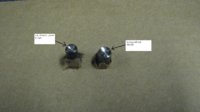Took the engine out of the '79 tonight. Not planning any major work, but it needs a thorough cleaning, the carbs had to come off for a rebuild anyway, and it just seemed easier to do with the engine out and on a stand.
There is a TON of gunk around the front sprocket. I haven't started cleaning things yet, and chances are it's from 30 years of over-oiling the chain. OTOH, it could be a dried out countershaft seal or a clutch pushrod seal (if there is one, I don't remember).
There's also a lot of slime on the bottom of the engine. I'm guessing the process of removing the sump plate to check the sump filter and replacing it (along with new gaskets and proper torque) will take care of most of that.
My question is this: If I start running into worn out seals, are these parts reasonably easy to find? If so, where do I look?
Also, while I'm asking stoopid questions, how's availability on new sprockets? The chain is wore slap out, and if I'm going to replace the chain, I may as well replace the sprockets. Stock ratio is fine.
There is a TON of gunk around the front sprocket. I haven't started cleaning things yet, and chances are it's from 30 years of over-oiling the chain. OTOH, it could be a dried out countershaft seal or a clutch pushrod seal (if there is one, I don't remember).
There's also a lot of slime on the bottom of the engine. I'm guessing the process of removing the sump plate to check the sump filter and replacing it (along with new gaskets and proper torque) will take care of most of that.
My question is this: If I start running into worn out seals, are these parts reasonably easy to find? If so, where do I look?
Also, while I'm asking stoopid questions, how's availability on new sprockets? The chain is wore slap out, and if I'm going to replace the chain, I may as well replace the sprockets. Stock ratio is fine.

